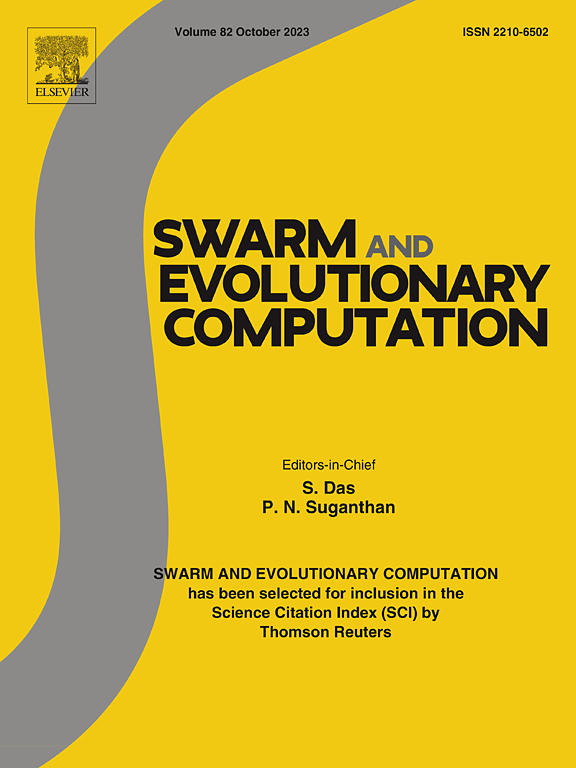Multi-objective dynamic economic emission dispatch considering the risk of wind power-electric vehicle interaction using teaching-learning-based optimization algorithm
IF 8.5
1区 计算机科学
Q1 COMPUTER SCIENCE, ARTIFICIAL INTELLIGENCE
引用次数: 0
Abstract
As the traditional energy systems dominated by fossil fuels transform into renewable energy, more and more renewable energy, such as wind power, are being integrated into the power system. However, due to the strong randomness of wind power, it will extremely affect the security of the power grid. Electric vehicles (EVs) can mitigate the instability of wind power through their energy storage capabilities, but the charging/discharging behavior of large-scale EVs is intensely unstable. Therefore, to assess the uncertainty of the interaction between wind power and EV (IWEv), a dynamic economic emission dispatch (DEED) model based on the conditional value at risk (CVaR) of IWEv (DEEDR-IWEv) is proposed considering the pollution emission, fuel cost and the system operation risk. Besides, some practical constraints such as the power balance, the residual power of the EVs, travel constraints for EVs owners, charging and discharging power, and climbing rate are included in DEEDR-IWEv. To obtain a satisfactory dispatching solution, a self-adaptive multi-mode teaching-learning-based optimization (SaMmTLBO) algorithm is proposed. In SaMmTLBO, the teaching factors in the teacher phase is improved to enhance the diversity, and then a parameter self-adaptive mechanism and multi-model learning are developed in learn phase to increase the efficiency. Finally, the feasibility and effectiveness of the proposed model and algorithm are validated on a 10-unit system.
基于教-学优化算法的考虑风电-电动车交互风险的多目标动态经济排放调度
随着以化石燃料为主的传统能源系统向可再生能源的转变,越来越多的可再生能源,如风能,正在被纳入电力系统。然而,由于风电的随机性强,将极大地影响电网的安全运行。电动汽车可以通过自身的储能能力缓解风力发电的不稳定性,但大型电动汽车的充放电行为具有强烈的不稳定性。为此,为了评估风电与电动汽车(IWEv)相互作用的不确定性,考虑污染排放、燃料成本和系统运行风险,提出了基于条件风险值(CVaR)的IWEv (DEEDR-IWEv)动态经济排放调度(DEED)模型。此外,DEEDR-IWEv还考虑了功率平衡、电动汽车剩余功率、电动汽车车主出行约束、充放电功率、爬升率等实际约束条件。为了获得满意的调度解,提出了一种自适应多模式教-学优化算法(SaMmTLBO)。SaMmTLBO通过改进教师阶段的教学因素来增强多样性,在学习阶段建立参数自适应机制和多模式学习来提高效率。最后,在一个10单元系统上验证了所提模型和算法的可行性和有效性。
本文章由计算机程序翻译,如有差异,请以英文原文为准。
求助全文
约1分钟内获得全文
求助全文
来源期刊

Swarm and Evolutionary Computation
COMPUTER SCIENCE, ARTIFICIAL INTELLIGENCEC-COMPUTER SCIENCE, THEORY & METHODS
CiteScore
16.00
自引率
12.00%
发文量
169
期刊介绍:
Swarm and Evolutionary Computation is a pioneering peer-reviewed journal focused on the latest research and advancements in nature-inspired intelligent computation using swarm and evolutionary algorithms. It covers theoretical, experimental, and practical aspects of these paradigms and their hybrids, promoting interdisciplinary research. The journal prioritizes the publication of high-quality, original articles that push the boundaries of evolutionary computation and swarm intelligence. Additionally, it welcomes survey papers on current topics and novel applications. Topics of interest include but are not limited to: Genetic Algorithms, and Genetic Programming, Evolution Strategies, and Evolutionary Programming, Differential Evolution, Artificial Immune Systems, Particle Swarms, Ant Colony, Bacterial Foraging, Artificial Bees, Fireflies Algorithm, Harmony Search, Artificial Life, Digital Organisms, Estimation of Distribution Algorithms, Stochastic Diffusion Search, Quantum Computing, Nano Computing, Membrane Computing, Human-centric Computing, Hybridization of Algorithms, Memetic Computing, Autonomic Computing, Self-organizing systems, Combinatorial, Discrete, Binary, Constrained, Multi-objective, Multi-modal, Dynamic, and Large-scale Optimization.
 求助内容:
求助内容: 应助结果提醒方式:
应助结果提醒方式:


